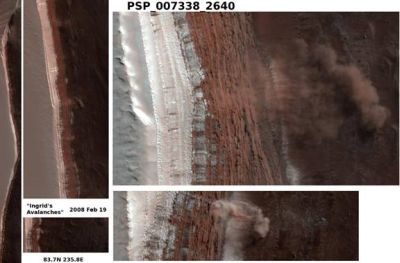04 March 2008

This unique image has captured at least four Martian avalanches, landslides, in action. It was taken on 19 February 2008, by the High Resolution Imaging Science Experiment (HiRISE) camera onboard NASA's Mars Reconnaissance Orbiter.
Image Credit: NASA/JPL-Caltech/University of Arizona
A NASA spacecraft in orbit around Mars has taken the first ever image of active avalanches near the Martian north pole. The image shows tan clouds drifting away from the flank of a high slope, where ice and dust have just cascaded down.
The High Resolution Imaging Experiment (HiRISE) onboard NASA's Mars Reconnaissance Orbiter (MRO) took the image on 19 February 2008. It is one of approximately 2,400 HiRISE images that were released recently.
Ingrid Daubar Spitale (University of Arizona) who directs the camera and has studied numerous HiRISE images was the first person to spot the avalanches. "It really surprised me," she said. "It's great to see something so dynamic on Mars. A lot of what we see there hasn't changed for millions of years."
The camera monitors Martian seasonal changes. However, the main target of the 19 February 2008 image was not the steep slope.
"We were checking for springtime changes in the carbon-dioxide frost covering a dune field, and finding the avalanches was completely serendipitous," said Candice Hansen, Deputy Principal Investigator for HiRISE, at NASA's Jet Propulsion Laboratory (JPL).
The full image reveals features as small as a desk in a strip of terrain 6 km wide and over 60 km long, at 84 degrees north latitude. Reddish layers, known to be rich in water ice, make up the face of a steep slope more than 700 m high, extending along the image.
"We don't know what set off these landslides," said Patrick Russell, a HiRISE team collaborator. "We plan to take more images of the site through the changing Martian seasons to see if this kind of avalanche happens all year or is restricted to early spring."
Probably ice is more abundant than dust in the material that fell from the upper portion of the scarp. Imaging of the site during coming months will track any changes in the new deposit at the base of the slope. That will yield an estimate of the proportion of ice.
"If blocks of ice broke loose and fell, we expect the water in them will be changing from solid to gas," said Russell. "We'll be watching to see if blocks and other debris shrink in size. What we learn could give us a better understanding of one part of the water cycle on Mars."
MRO reached Mars in March 2006, and has relayed more data than all other current and past missions to Mars combined.
"Our Mars program is the envy of the world," said Alan Stern, Associate Administrator of NASA's Science Mission Directorate. "We plan to launch a total of five more missions in the next decade, beginning with the Mars Science Lab Rover next year and a Mars Aeronomy Scout mission in 2013."
Further Reading
MRO
http://www.nasa.gov/mro
http://hirise.lpl.arizona.edu
Aymen Mohamed Ibrahem
Senior Astronomy Specialist